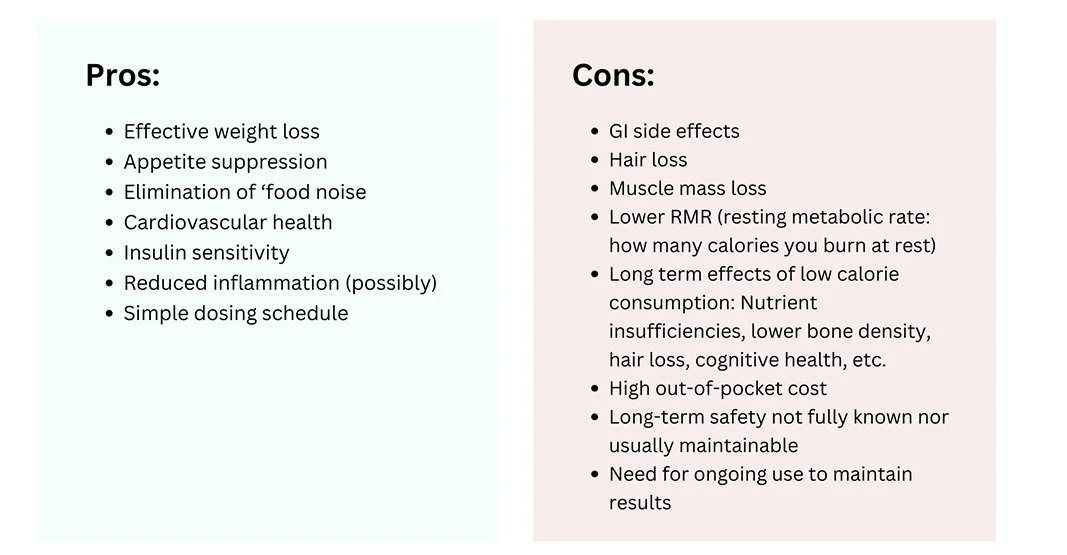The Pros and Cons of GLP Medications for Weight Optimization
GLP medications have exploded on the health care scene this year. It seems like they could be the ‘magic weight loss pill’ we have been hoping for. There are numerous benefits of GLP’s, but still a lot more things to consider to get the most out of GLP therapies and avoid any pitfalls.
Read on to learn the pros & cons of GLP’s and how to get the most benefits if you chose to use GLP therapies.
What Are GLP Medications?
GLP’s (glucagon-like peptide-1 receptor agonists) are medications that mimic the natural hormone, glucagon. They work by engaging the same receptors on target cells as glucagon does, triggering a cascade of different effects in our body including blood sugar regulation, insulin secretion and appetite control and potentially even immune modulation.
There are several types of GLP medications that engage different types of glucagon receptors, giving them different effects in different people:
Single receptor agonists (GLP-1 only): Ozempic, Wegovy, Saxenda
Dual receptor agonists (GLP-1 + GIP): Mounjaro, Zepbound
Triple receptor agonists (GLP-1 + GIP + glucagon): in development—early studies show even greater metabolic effects
These medications are changing how we are able to ameliorate obesity, food addiction, insulin resistance, and cardiometabolic risks. And that’s no small thing. “Metabolic syndrome” -basically heart disease, diabetes and their related conditions- are the top causes of death in the US and top costs to our health care system.
Not to mention how excess weight affects our relationship with food, our bodies and our identities.
How Do GLP Medications Support Weight Loss?
Originally developed for type 2 diabetes, GLP’s can decrease weight in 2 main ways. They work by slowing gastric emptying which makes you feel fuller. This triggers our brains to tell us we are satiated, or full. People often report that for the first time in their lives, they aren’t constantly thinking about food and can leave a plate unfinished. Many people feel liberated to be free of the constant “food noise” and food bargaining.
Why are GLP’s needed?
If we want to know how to best use GLP’s it is important to think about how we, as a society and as individuals, ended up in an obesity epidemic.
The fact is, our biology is programmed for a very different environment than our current surroundings.
Throughout human history up until recently our ancestors dealt with food scarcity on a very regular basis. We did not have a pantry full of food and there were no grocery or convenience stores, restaurants or fast food places to get food at any moment.
On top of that, humans moved, on average, 5-9 miles per day, just as part of meeting their daily needs.
Because of these influences throughout our history, many of our bodies and brains adapted to hold on to weight, to seek pleasurable foods and tend towards inactivity when ever we can (which is a lot these days!).
Today, however, we are surrounded, bombarded even, with highly and ultra-processed foods everywhere, ready at the touch of a button or a quick trip to the store. On top of that, Americans move on average, less than a mile a day. Processed foods and screen-time are also highly addictive to the human brain. They can lower our will power and heighten our pleasure-seeking behaviors, leading us to be addicted to processed food, over-eating. This then can leave us feeling less than energetic, compromising sleep and further compounding inactivity.
Conclusion: many of us have become ‘victims’ of the mismatch between our biological predispositions and our modern environment. We were designed to survive in an environment in which we were highly active and had much less access to food (and no processed foods) while our modern life is based on processed foods & is highly sedentary.
It can be very difficult to get out of this vicious cycle, and GLP’s may be a golden opportunity to break free from this cycle.
Benefits of GLP Medications
Weight loss is the number one benefit of GLP therapy for most, but not all people. This happens because GLP’s improve satiety, insulin-sensitivity and can decrease “food noise,” in the brain.
Fat, or adipose cells, themselves secrete molecular signals that exert control over our blood sugar regulation, insulin sensitivity, appetite and inflammation. So the shrinking of fat cells can change our hunger signaling in a compound effect.
Loss of fat cells and weight benefits all conditions associated with excess adipose cells and their inflammatory signalling. Most notably, the top causes of human death, heart disease, diabetes, kidney disease, liver inflammation (fatty liver) but also improving joint issues that can be caused by excess weight, aging and inactivity including back, hip and knee pain and surgeries.
Not to mention, decreased weight can allow us to be more active, a win-win for weight loss and health.
GLP’s also appear to have an effect on the immune system and inflammation. Along with the improvements in inflammation that occur due to weight loss and improved insulin sensitivity, GLP’s appear to directly modulate the immune system by engaging receptors on immune cells. Some patients report reduced symptoms of inflammation after the very first dose -meaning it can’t be due to weight loss or improved insulin sensitivity yet.
Low-dose GLP treatments are being trialed for some chronic inflammatory conditions such as MCAS (mast cell activation syndrome).
Are there any downsides to GLP therapies?
GLP’s can help us lose weight, but weight loss alone is not a panacea for health. Decreased calorie & nutrient intake and potentially muscle loss can lead to other consequences if not appropriately orchestrated into a personalized health plan.
Skinny does not equal health.
Here are the top side effects to pay attention to:
GI symptoms. Nausea/vomiting, constipation/bloating or diarrhea is one of the most common side effects and unless it is transient, can make the medications intolerable for some. Pancreatitis (inflammation of the pancreas) can happen as well.
Muscle loss. With too rapid weight loss or failure to build or maintain muscle mass, you could actually become weaker with muscle loss. Less muscle mass also means a lower RMR (resting metabolic weight).
Inadequate nutrients and protein. While ok in the short term, long term, significant nutrient, protein and calorie intake puts you at higher risk of certain conditions, including bone loss (osteoporosis), a compromised immune system, hair loss, compromised cell health, nutrient deficiencies, weakness & fatigue, hormonal imbalances, cognitive impairment and sleep disturbances.
On a low calorie diet (<1500-2000 calories, depending on your size) you’d have to eat a diet 100% packed full of nutrients and macros (protein, healthy fat and carbs) to get the nutrients necessary for long-term wellness.
Cost and insurance coverage issues. Insurance coverage for GLP’s vary widely, with some covering it for weight loss and others barely covering it for diabetes and only certain types. The $400 -$800 monthly cost is not maintainable for long for most people.
What’s next? We don’t have long term studies on GLP’s, and the cost often negates it as a long-term therapy anyway. If you don’t use the GLP medications as a tool in a larger health program to jumpstart healthy life plan, you’ll likely end up back where you started, only with potentially less muscle mass, nutrient insufficiencies and a lower metabolic rate.
How To Make The Most Out Of GLP’s
Now that we understand how we ended up in an obesity epidemic and the pros and potential pitfalls of glutide therapies, let’s go over how to utilize them to their best effects.
Nutrition: Maximize your nutrient-dense foods and focus on protein if you are consuming <1500 calories. It’s as important to focus on what you do eat as it is what you don’t eat. Remember to “Eat the rainbow” & “Shop the periphery” of the grocery store: meaning avoid processed foods and eat a variety of vegetables, fruits, lean protein and ‘healthy’ carbs such as whole grain rice, yams and sweet potatoes.
Exercise! Let the GLP help you lose fat while maximizing muscle mass. The weight and potentially inflammation lowering ability of GLP’s is a great time to jump-start a fitness program! This is also the best way to maximize fat loss while maintaining that metabolically ‘hot’ muscle tissue to keep your resting metabolism high while on a lower calorie diet (which can suppress metabolism).
Remember: Start where you are with your fitness, and work up to your fitness goals (rather than start where you want to be, which may be too much at first!)
How much exercise? If you aren’t already active, start by working towards maintaining the basic government recommendations for physical activity for health benefits are:
150 minutes of cardiovascular exercise per week
30 x 30 minute strength sessions.
Sleep & Stress management: Losing weight is not a substitute for getting enough sleep and reducing or working on stress resilience techniques such as therapy, mindfulness and healthy boundaries. Insufficient/not enough sleep and stress are key dysregulators of weight, insulin sensitivity and inflammation in the body, all things we are trying to optimize with GLP’s.
[Stay tuned for a future article, we’ll tell you about how another health metric, VO2max, is actually far superior to weight and for accomplishing your weight and health goals]
What if GLP’s aren’t solving my weight issues?
If GLP’s aren’t leading to weight loss for you, then a number of things may be happening:
You may still be eating more calories than your basic metabolic rate. This often happens if:
We are still eating processed or calorie dense foods.
GLP induced weight & muscle loss has lowered your metabolic rate.
You have other health issues causing your body to hold on to weight or lower your metabolism.
Thyroid issues, inflammation, stress and other hormonal imbalances are key areas.
Food addictions and food relationship imbalances.
Despite GLP’s actions on lowering appetite, dysregulated food relationships or food addiction can overpower this and lead us to overeat.
You need to boost metabolism and muscle mass through exercise & strength training.
Adaptation to the medications, requiring higher and higher doses to maintain the same satiety effects
Individual biologic differences, leading to different effects of GLP medications than the norm.
You can’t pay the cost long term!
Whether you feel GLP’s are working brilliantly for you or not, you can see why it is still important to use them as a springboard for your weight optimization journey and not a magic bullet.
Pros and Cons of GLP Medications
GLP medications have changed how we approach weight loss and metabolic health. But like any powerful treatment, they come with pros and cons. Here’s a clear look at both the benefits and the drawbacks.
Final Thoughts: Is It Right for You?
GLP’s are may be as close to a magic drug for the modern epidemic of obesity as we have found so far. But it shouldn’t be considered a stand-alone miracle for all things obesity related. If we understand the root causes of our weight issues and address them, GLP therapies may be a liberating tool to get on track with your health.
Remember, GLP’s and weight loss alone are not the panacea for all things health related. They should be used in conjunction with a nutrient dense diet and a focus on gaining physical fitness and building or maintaining muscle mass. If we don’t pair them with appropriate lifestyle changes, they can have negative consequences such as muscle mass loss, nutrient depletion, hair loss and rebound weight gain once discontinued, especially considering the lower RMR from weight and potentially muscle loss.
If GLP’s are the right catalyst to your health journey don’t just focus on weight loss! Work with an educated provider who will help you customize your health, nutrition & lab markers with this potent tool.


